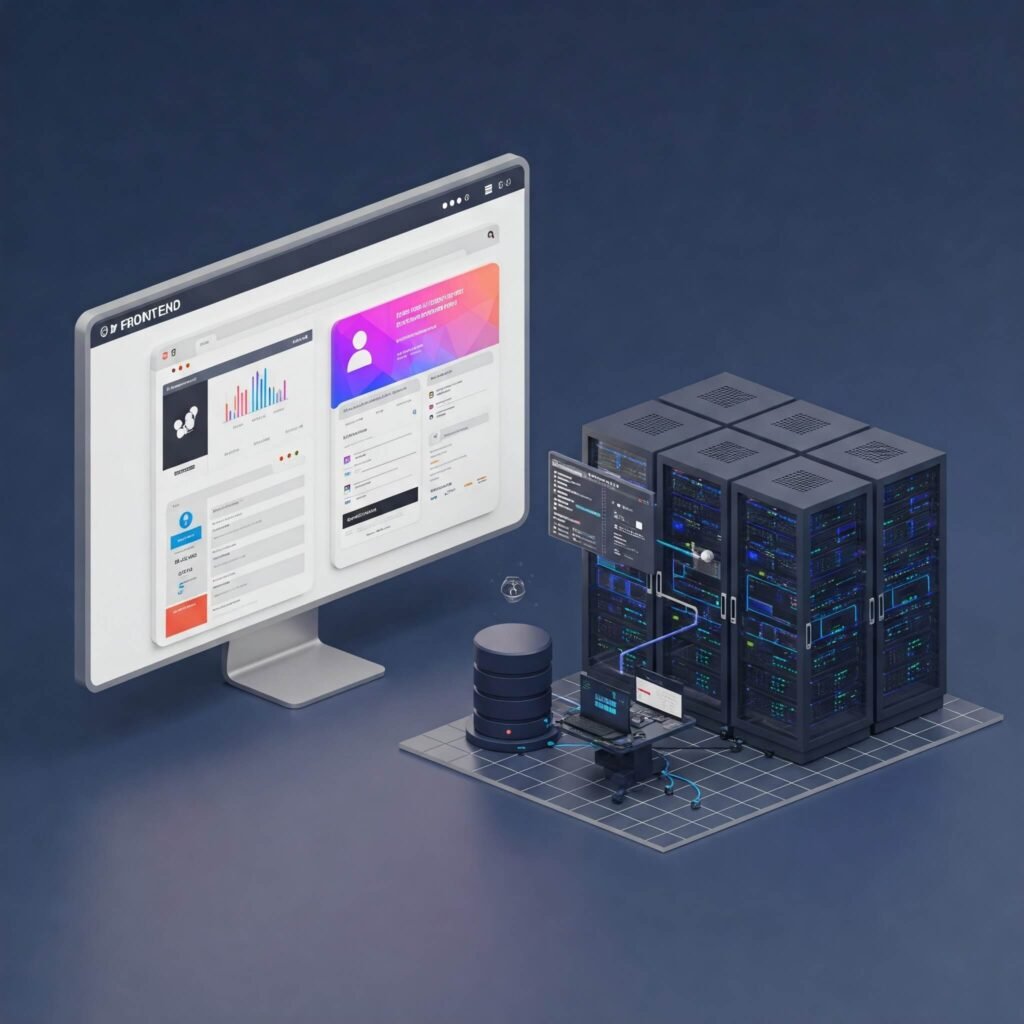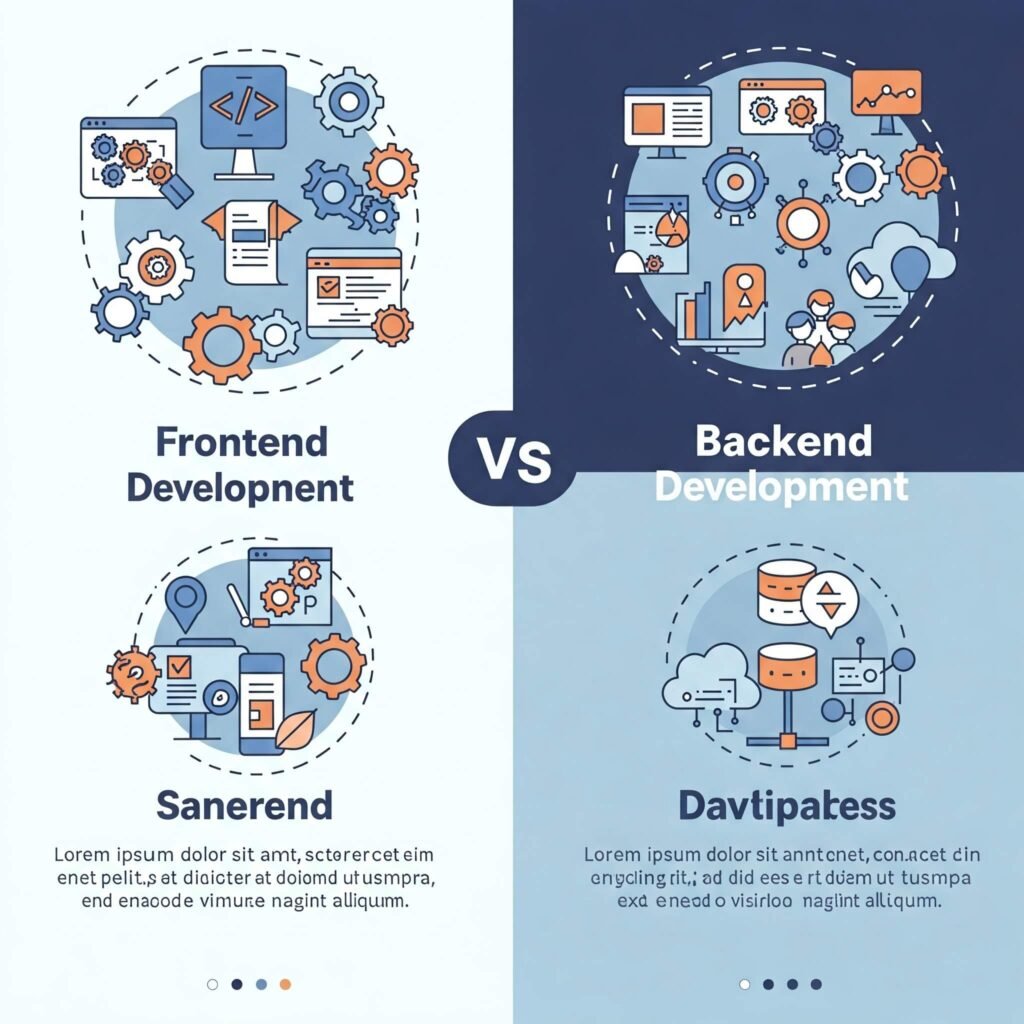Frontend vs Backend: What’s the Difference in 2025?
Frontend vs backend: what’s the difference? If you’ve ever wondered how websites like Netflix or Amazon work so seamlessly, it’s thanks to the collaboration between frontend and backend development. Frontend creates the user-facing visuals you see, while backend powers the behind-the-scenes logic. This guide explains the differences, roles, tools, and real-world examples in a friendly, clear way, perfect for beginners, aspiring developers, or tech enthusiasts in 2025.
What Is Frontend vs Backend Development?
Frontend vs backend refers to the two core pillars of web development. Frontend development focuses on what users see and interact with, like buttons and layouts. Backend development handles the server-side logic, databases, and functionality that power the site.
Quick Breakdown:
- Frontend: The “client-side” part—think visuals, design, and user experience.
- Backend: The “server-side” part—think data management, servers, and application logic.
- Together: They create a fully functional website, like Spotify’s sleek interface (frontend) and music streaming (backend).
Understanding this split is key to grasping how websites function.

Frontend Development: Crafting the User Experience
Frontend vs backend starts with frontend, the part users see and interact with developers use tools like HTML, CSS, and JavaScript to design responsive, engaging interfaces.
- Design: Creating layouts, colors, and visuals, like Airbnb’s clean booking interface.
- Interactivity: Adding features like buttons or sliders, as seen on Instagram’s feed.
- Responsiveness: Ensuring sites work on mobile and desktop, per Google’s mobile-first indexing.
Popular Frontend Tools:
- Frameworks: React, Vue.js, Angular (e.g., Netflix uses React for its UI).
- CSS Tools: Tailwind CSS, Bootstrap for styling.
- Design Tools: Figma for prototyping.
For example, Apple’s website uses React to deliver smooth animations and responsive design.
Actionable Tip: Learn HTML, CSS, and JavaScript via freeCodeCamp to start frontend development.
Outbound Link: React Documentation for frontend framework insights.
Backend Development: Powering the Website
Frontend vs backend shifts to backend, the invisible engine that makes websites function. Backend developers manage servers, databases, and logic to ensure data flows smoothly.
Backend Responsibilities:
- Data Management: Storing user info, like Amazon’s product database.
- Server Logic: Handling requests, such as processing a payment on PayPal.
- APIs: Connecting frontend to backend, like Twitter’s API for real-time feeds.
Popular Backend Tools:
- Languages: Python (Django), JavaScript (Node.js), PHP (Laravel).
- Databases: MySQL, MongoDB (e.g., LinkedIn uses MongoDB for user data).
- Servers: AWS, Google Cloud for hosting.
For instance, Uber’s backend uses Node.js to process ride requests and match drivers in real-time.
Actionable Tip: Start with Python and Django for beginner-friendly backend development.

How Frontend and Backend Work Together
Frontend vs backend isn’t a rivalry—they’re a team. The frontend sends user requests (e.g., clicking “Buy Now”) to the backend, which processes them (e.g., updating inventory) and sends data back for display.
How They Collaborate:
- APIs: Act as messengers, like Spotify’s API delivering song data to its frontend.
- Full-Stack Development: Combines both, as seen in small teams building apps like Notion.
- DevOps: Tools like Docker ensure smooth deployment, used by GitHub.
For example, when you shop on Etsy, the frontend shows products, while the backend handles payments and inventory updates.
Actionable Tip: Learn REST APIs with Postman to bridge frontend and backend.
Outbound Link: Postman for API development resources.
Frontend vs Backend: Key Differences at a Glance
Frontend vs backend can be summarized with their distinct roles, tools, and focus areas.
Comparison Table:
- Frontend:
- Focus: User interface and experience.
- Tools: HTML, CSS, JavaScript, React.
- Example: Designing Netflix’s video player UI.
- Backend:
- Focus: Server, database, and logic.
- Tools: Python, Node.js, MongoDB.
- Example: Streaming videos on Netflix’s servers.
Statista reports 80% of developers specialize in either frontend or backend, but 20% are full-stack, blending both.
Actionable Tip: Choose frontend for design passion or backend for data-driven logic, based on your interests.

Challenges in Frontend vs Backend Development
Frontend vs backend both face unique challenges in 2025, impacting how developers approach their work.
Frontend Challenges:
- Cross-Browser Compatibility: Ensuring sites work on Chrome, Safari, etc.
- Performance: Optimizing load times, as 53% of users abandon slow sites (Google).
- Accessibility: Meeting WCAG standards for inclusivity.
Backend Challenges:
- Scalability: Handling traffic spikes, like Black Friday on Walmart’s site.
- Security: Protecting data, as seen in Equifax’s 2017 breach.
- Complexity: Managing large databases, like YouTube’s video storage.
Actionable Tip: Use Lighthouse for frontend audits and OWASP guidelines for backend security.
Outbound Link: OWASP Security Guidelines for backend best practices.
How to Get Started with Frontend or Backend
Frontend vs backend: how do you choose and start? Both paths are rewarding, and 2025 offers plenty of resources to learn.
Getting Started:
- Frontend: Learn HTML/CSS/JavaScript via MDN Web Docs. Build a portfolio site with React.
- Backend: Start with Python/Django or Node.js. Create a simple API with Express.
- Full-Stack: Combine both with a project like a to-do app using MERN (MongoDB, Express, React, Node.js).
- Communities: Join DEV Community or X for tips and networking.
Try building a clone of a site like Trello (frontend for UI, backend for task storage) to practice.
Actionable Tip: Take a free course on Coursera to master either discipline.
Conclusion: Frontend vs Backend—Which Path for You?
Frontend vs backend: what’s the difference? Frontend crafts the visuals users love, while backend ensures the site runs smoothly. Together, they power the web, from Netflix to Uber. Whether you lean toward design or logic, understanding both unlocks endless opportunities. Start exploring frontend or backend today to shape the digital future.



































